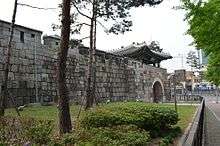Gwanghuimun
Gwanghuimun (Hangul 광희문, Hanja 光熙門; also known as Southeast Gate) is one of The Eight Gates of Seoul in the Fortress Wall of Seoul, South Korea, which surrounded the city in the Joseon Dynasty. The gate is also known as Namsomun (남소문, “South Small Gate”). It was originally called Sugumun "Water Channel Gate."
| Gwanghuimun | |
.jpg) Gwanghuimun, February 2014 | |
| Korean name | |
|---|---|
| Hangul | |
| Hanja | |
| Revised Romanization | Gwanghuimun |
| McCune–Reischauer | Kwanghŭimun |
History
Gwanghuimun was originally built in 1396, and was rebuilt from 1711-1719. It was the only gate to be left virtually untouched during the Japanese Occupation. However, it was largely destroyed during the Korean War, but was restored in 1976.[1]
The name Gwanghuimun means literally “Bright Light Gate.”[2]
The Gate today
Gwanghuimun is located in Jung-gu, Gwanghui-dong 2-ga, Seoul, at the intersection of Geumhodong-gil and Toegye-ro. The current gate is located slightly further south than the original gate, due to road construction.
The gate can be easily accessed from the Dongdaemun History & Culture Park Station, which is located on both subway line 2 and subway line 4. It is located about 1/2 block south from subway line 2, exit 3; and about 2 1/2 blocks east from subway line 4, exit 4. Visitors to the gate today are not allowed access above the gate, but can go through the gate and circle the section of the Fortress Wall it is connected to.
Gallery
 Gwanghuimun Gate, Seoul, Korea
Gwanghuimun Gate, Seoul, Korea Gwanghuimun gate Back, Seoul, Korea
Gwanghuimun gate Back, Seoul, Korea Gwanghuimun Gate, with Fortress Wall, Seoul, Korea
Gwanghuimun Gate, with Fortress Wall, Seoul, Korea Gwanghuimun Signboard, Seoul, Korea
Gwanghuimun Signboard, Seoul, Korea Gwanghuimun Gate, back with Fortress Wall, Seoul, Korea
Gwanghuimun Gate, back with Fortress Wall, Seoul, Korea Gwanghuimun Gate, front, stonework of Fortress Wall, Seoul, Korea
Gwanghuimun Gate, front, stonework of Fortress Wall, Seoul, Korea Gwanghuimun Gate, back stonework, Seoul, Korea
Gwanghuimun Gate, back stonework, Seoul, Korea Gwanghuimun Gate, Gatehouse, Seoul, Korea
Gwanghuimun Gate, Gatehouse, Seoul, Korea Gwanghuimun Gate, across street, Seoul, Korea
Gwanghuimun Gate, across street, Seoul, Korea
References
- "Gwanghuimun Gate". Exploring Korea. Archived from the original on 2012-06-11. Retrieved 2012-07-05.
- "The Gates and Walls of Seoul". Korean News Today. Archived from the original on 2012-12-08. Retrieved 2012-07-05.